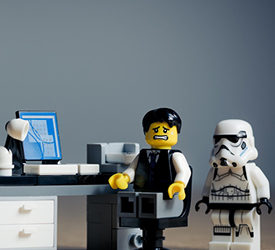Snooze… Snooze… Snooze… you can only snooze so many times before starting your day later than you should – it’s now 6 am and it’s go time! First thing’s first, you grab your phone and look over your feeds; news, social media, and calendar. You notice that you have a boring meeting scheduled first thing in the morning but can’t recall:
-
- Why are you attending?
- How and what will you be contributing?
- What’s the best outcome you can expect?
If you’re dreading the fact that you’ll have to attend yet another pointless boring meeting you have my sympathy; we’ve all been there. I think there’s a common misconception about meetings. A meeting isn’t just a discussion with co-workers/clients about a particular topic… a meeting is much more than that. After all, “Time is Money” and “Money is King”!
Let’s say you spend 5 hours a week attending boring meetings that have little value. That’s effectively 260 hours that you and your company could have spent on other important tasks in a year. Keep in mind that you’re not the only employee at your company who’s attending meetings! If you’re having these experiences, other people are too!
A meeting must have a purpose and an expected outcome. For example; you could have a meeting with the purpose of identifying which new Enterprise Resource Planning systems the company should consider when replacing its legacy ERP system. The outcome of the said meeting may not necessarily align with your initial expectations but there’s always an outcome.
In my experience, there are two culprits for ineffective boring meetings:
- Lack of information
- Lack of focus
Lack of information is an easy problem to fix! Any given meeting should be comprised of the following:
- Start time – time at which everyone will join the meeting
- End time – time at which everyone will leave the meeting
- Meeting Organizer – the person who’s facilitating the conversations
- Team Members – subject matter experts that contribute to the meeting in order to achieve an outcome.
- Purpose – the reason for having said meeting
- Outcome – takeaways from said meeting
- Agenda– the topics of discussion
- Discussions – sharing of ideas to reach the desired outcome
- Location – how and where you’ll be meeting
This list shouldn’t surprise you as it content is common knowledge.
Lack of focus on the other hand is a little more challenging to resolve and it’s a byproduct of multitasking. There are plenty of studies out there indicating that multitasking results in inefficiencies. We’re all guilty of this, whether it’s chatting via an app with a co-worker or working on other assignments, we’re not 100% focused on the meeting. Here are 3 solutions that have worked well for me so far:
- Create Rules that are agreed upon by each participant
- Ensure that you have the right tools for the meeting
- Utilize Meeting Energizers to get everyone pumped
Rules that are clearly communicated can help maintain people’s focus within meetings. For example, if a meeting invite communicates to the participants that personal phones/handheld devices should not be brought into the meeting, the participants will not get distracted by these devices during the meeting. Each team may need or require different rules but the 3 most common ones I personally utilize are as follows:
- Show up on time: If everyone shows up on time, then the meeting can stay within the appointed time frame.
- Stay mentally and physically present: Putting away phones/other distractions allows each member to contribute to the discussion without raising questions that had been previously discussed.
- Listen and respect other people’s opinions: The point of a meeting is for people to collaborate together to reach the best possible outcome rather than having one person commandeer the meeting.
Tools are the enablers. They allow the participants to engage and share their thoughts in an effective way. Notepads & pens, whiteboard & markers, projectors/screens to name a few have different purposes and it’s important to know when to utilize them. For example:
- Whiteboards & markers would be among the best tools when having a collaborative brainstorming session. It’s free form and allows users to effectively communicate their thoughts and make revisions.
- Notepads & pens are a poor replacement for whiteboards & markers for collaborative tasks. That being said, they do have their own advantages. Notes were taken or the ideas that are written down are private. Depending on the activity, it may provide the participants with a sense of comfort which you wouldn’t get with a whiteboard.
- Projectors and screens are only useful when there’s a single presenter and he/she is running the meeting. They’re good for steering committees but not so great when trying to get everyone engaged in a brainstorming session. They can also be used to conduct virtual meetings and collaborate across borders.
Meeting Energizers are the best way to promote group interactions in meetings. Each meeting energizer is essentially a team activity that will boost the team morale/energy and in turn their focus! Team building activities can also act as energizers; they can result in some sort of lessons learnt, making the meeting an interactive method to fulfill the purpose and come up with an outcome. Here are a few examples that I’ve used on fun retrospectives:
- Rock, Paper, Scissors! The meeting organizer will show the team full body poses for Rock, Paper, and Scissors. Two teams are created so that they can face each other. The teams need to be in sync on which pose they will be taking when the meeting organizer calls out “Rock, Paper, Scissors.” If the members of the team do not take the same pose, they will automatically lose the match. Play an odd number of rounds so that one team can claim victory!
- Back to Back! The meeting organizer will instruct the team to get into pairs of similar sizes/weights. The pairs will sit on the ground with their feet lying flat and having their backs against each other. The purpose of this activity is to see which pair is able to stand up first while interlocking their arms together. The winning team will share what they learnt and explain how they worked together to make it happen.
There are plenty of other websites that are dedicated to meeting energizers and team-building activities. Just make sure that the meeting energizer you decide to use is somehow related to the meeting that you’re facilitating. Our NetSuite Time Tracking article teaches you how your team can spend their time wisely, you should continue reading at it.
At Trajectory, we try our best to make the most of each meeting, time is important, especially for our clients! Let me know if you have other suggestions/ideas on improving boring meetings and their effectiveness, and what you practice at your workplace!



